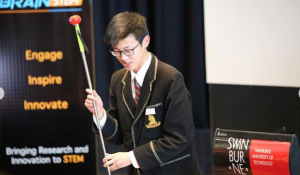Students’ passion for science stems from BrainSTEM

It is one thing to learn about science in school, but it is another thing to apply it to real-world applications. BrainSTEM fosters high school students’ engagement with the journey of scientific discovery for the benefit of the community with the guidance of a STEM mentor.
Over 75% of the jobs of the future will have a STEM basis, yet only 16% of high school graduates go on to study a STEM discipline at tertiary level. In addition, less than a third of Australian STEM graduates are women. Founder of BrainSTEM, Sid Verma, wants to see these numbers rise.
BrainSTEM provides a supportive learning environment for students to generate and explore innovative ideas, apply their learnings with experimental science, and connect them with a network of academic leaders.

The inspiration for the program stems from Sid’s personal experience. In 2015, his 15-year-old son, Dhruv Verma, created a system to monitor elderly people in their own homes. With this prototype, he represented Australia at the Intel International Science and Engineering Fair as one of 1,700 high school students from over 75 countries. Walking into the Fair and seeing the children and their projects, Sid was impressed.
‘Looking at these bright, switched-on kids, I know that we will be fine in the future,’ says Sid.
He found that there was a particularly striking difference between students who had been mentored by a scientist from their local university in terms of their depth of knowledge and relation to real-world problems and became increasingly concerned about the children in schools without the chance to put their hands up for opportunities such as this. ‘How far behind are some students through no fault of their own?’
Sid set out to make a difference – to ensure that even public school students without the same privileges as his son, at a prestigious private school, could have access to opportunities in STEM.
When Sid pitched the BrainSTEM program to Swinburne in 2015 to run the next month, they were happy to begin running it in a couple of years. Universities do not always work to fast timelines – but the business world does. With his background in business, Sid launched the program the next month with four teams of four students, and it took off.
The BrainSTEM Innovation Challenge, a 12-week mentoring program, has since run twelve times (and twice as digital iterations for regional areas to participate). Teams of students are matched with an academic mentor, develop an innovative solution to a real-world problem and then showcase their idea to the BrainSTEM community. To date, more than 600 Australian students have been mentored, totalling over 4000 hours of mentoring.
‘Being mentored by real scientists opened my mind to possibilities in the STEM industry and inspired me to follow my passion,’ says one student.

One of the students in the first Innovation Challenge was not a straight A student, nor did she know what she wanted to do when she finished high school. After 12 weeks with a mentor, however, she and her team developed a prototype of an instrument to measure oedema in children’s skulls. With equipment bought from a hardware store, the students built a fluid retention detection device and even presented it to surgeons at the Royal Children’s Hospital.
I myself mentored three students from Eltham High School, who came to visit me fortnightly at the Peter Doherty Institute for Infection and Immunity. I showed them around the laboratory and we would brainstorm ideas all over whiteboards. I told them about new technologies, such as the Nobel Prize-winning CRISPR gene-editing technology, and they thought about how they could use them to tackle a problem. They came up with a theoretical solution for heart transplant rejection – the inevitable rejection of a donated heart by the patient’s immune system – by using gene editing to prevent immune cells from attacking the new heart. They pitched their idea and outlined a plan to get it into pre-clinical trials and then the clinic, and I could see their excitement when thinking about all the problems they might be able to solve next.
From a one-man show, the BrainSTEM team has expanded to cope with the growing number of students who want to participate. They hope to connect with industry partners to give students a taste of industry as well as academia. They also plan to expand the program Australia-wide, and the inclusion of their first remote New South Wales team last year was a step forward.
Sid also expanded the BrainSTEM program to deliver professional development workshops. He took one Innovation Challenge team to a STEM conference in Sydney to present their project. One girl was intrigued by the things people were exchanging with each other – business cards – and so Sid helped her to “network” with people to collect some for herself. The Resilient Minds (Design Thinking) Workshops are tailored to help high school students develop their “soft skills” such as problem solving, critical thinking, and entrepreneurship, and gain confidence, all of which they can take into any career.
‘The workshops help you find your voice – it doesn’t have to be in STEM,’ says Sid. He is proud of the program’s success to date in that students have been empowered to pursue their passions and learn important problem-solving and professional skills that they can take into the workplace.
This article was prepared by Catriona Nguyen-Robertson and talks about BrainSTEM, its founder Sid Verma, and the amazing work they do in STEM outreach and engagement.
